
The Calliphoridae are a family of insects in the order Diptera, with almost 1,900 known species. The maggot larvae, often used as fishing bait, are known as gentles. The family is known to be polyphyletic, but much remains disputed regarding proper treatment of the constituent taxa, some of which are occasionally accorded family status.

Sarcophagidae are a family of flies commonly known as flesh flies. They differ from most flies in that they are ovoviviparous, opportunistically depositing hatched or hatching maggots instead of eggs on carrion, dung, decaying material, or open wounds of mammals, hence their common name. Some flesh fly larvae are internal parasites of other insects such as Orthoptera, and some, in particular the Miltogramminae, are kleptoparasites of solitary Hymenoptera. The adults mostly feed on fluids from animal bodies, nectar, sweet foods, fluids from animal waste and other organic substances. Juveniles need protein to develop and may be laid on carrion, dung or sweet plant foods.
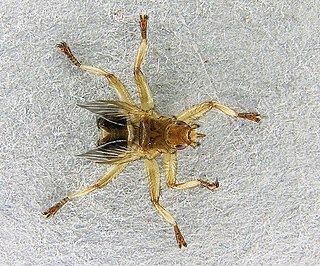
Hippoboscidae, the louse flies or keds, are obligate parasites of mammals and birds. In this family, the winged species can fly at least reasonably well, though others with vestigial or no wings are flightless and highly apomorphic. As usual in their superfamily Hippoboscoidea, most of the larval development takes place within the mother's body, and pupation occurs almost immediately.
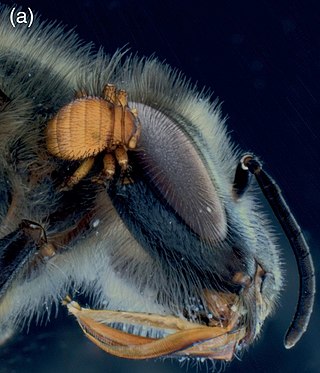
Braulidae, or bee lice, is a family of true flies (Diptera) with seven species in two genera, Braula and Megabraula. They are found in honey bee colonies due to their phoretic, inquiline, and kleptoparasitic relationships with the bees. Similar in appearance but not closely related to keds, these flies are also small, wingless, and occasionally mistaken for mites or lice, hence their common name.

The Chamaemyiidae are a small family of acalyptrate flies with less than 200 species described worldwide. The larvae of these small flies are active and predatory and are often used for biological control of aphids, scale insects, and similar pests. Chamaemyiid fossils are poorly represented in amber deposits, but a few examples are known from the Eocene epoch onwards.
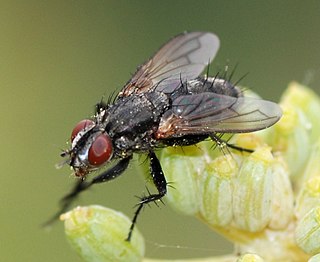
Rhinophoridae is a family of flies (Diptera), commonly known as Woodlouse Flies, found in all zoogeographic regions except Oceania, but mainly in the Palaearctic and Afrotropical regions.

Carnidae, also known as bird flies or filth flies, is a family of flies (Diptera). There are 6 genera, containing about 93 species worldwide.
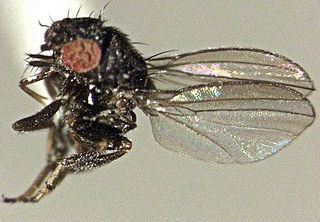
Milichiidae are a family of flies. Most species are very small and dark. Details of their biology have not yet been properly studied, but they are best known as kleptoparasites of predatory invertebrates, and accordingly are commonly known as freeloader flies or jackal flies. However, because of the conditions under which many species breed out, they also are known as filth flies.
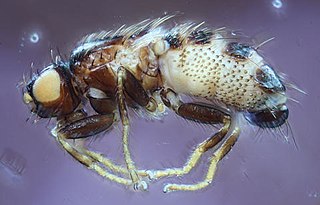
Carnus hemapterus is a Dipteran insect, a small-bodied and partly black-coloured carnid fly. In their adult stage of life, they are blood-sucking ectoparasites of nestling birds. Within the genus Carnus, this is the only species widespread across Europe and the cold and temperate regions of Asia and North America. Female body length is about 1.5 mm, males are smaller. It typically occurs in the nests of medium- to large-bodied birds, provided that the nest is not on the ground. It is particularly common on the chicks of owls, falcons, rollers, bee-eaters and starlings. Females give birth to larvae that live within the nest and feed on organic debris and the pupae also overwinter there. The emergence of imagines is synchronized to the hatch of host nestlings in the subsequent year. They prefer larger chicks within the nest. Adult flies have a winged and an unwinged variety, the latter being more common. In fact, unwinged flies still carry the basal part of their wings, but the majority of the wing is broken off. Flies live only on the nestlings before and during the development of the plumage, and disappear later on.

The Cylindrotomidae or long-bodied craneflies are a family of crane flies. More than 65 extant species in 9 genera occur worldwide. There are more than 20 extinct species.
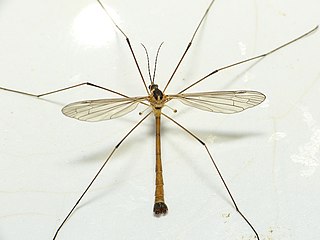
The Cylindrotominae are one of two subfamilies in the family Cylindrotomidae. They typically have an long body relative to their wing size.

Tachydromiinae is a subfamily of hybotid flies widespread in the world.

Braula is a genus of flies (Diptera) in the family Braulidae. These are very unusual flies, wingless and flattened, and barely recognizable as Diptera. Braula coeca Nitzsch is a pest of honey bees. The larvae tunnel through the wax honeycomb and the adults are found on the bodies of honey bees. There is some debate whether the bee louse causes damage to the honey bee. These flies sometimes can be found at places where bees congregate such as flowers or salt licks, waiting to grab onto hosts from uninfested nests. Braula is cosmopolitan and about 1.6 mm in length.
Eutherini is a tribe of flies in the family Tachinidae.
Meoneura is a genus of carnid flies (Diptera).

Colpocephalum is a genus of chewing louse. Christian Ludwig Nitzsch named the genus in 1818. The Plenary Powers of the International Commission on Zoological Nomenclature selected Colpocephalum zebraBurmeister, 1838 as its type species in the 1950s. There are approximately 135 species in this genus, and they are ectoparasites of birds in at least a dozen different orders.

Chrysopsinae is an insect subfamily in the family Tabanidae commonly known as deer flies or sheep flies and are bloodsucking insects considered pests to humans and cattle. They are large flies with large brightly-coloured compound eyes, and large clear wings with dark bands. They are larger than the common housefly and smaller than the horse-fly.

Braula coeca, the bee louse, is a species of bee louse in the family Braulidae.
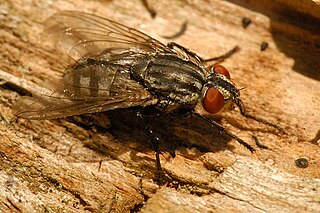
Brachicoma is a genus of true flies in the family Sarcophagidae.
Menopon is a genus of lice belonging to the family Menoponidae.

















